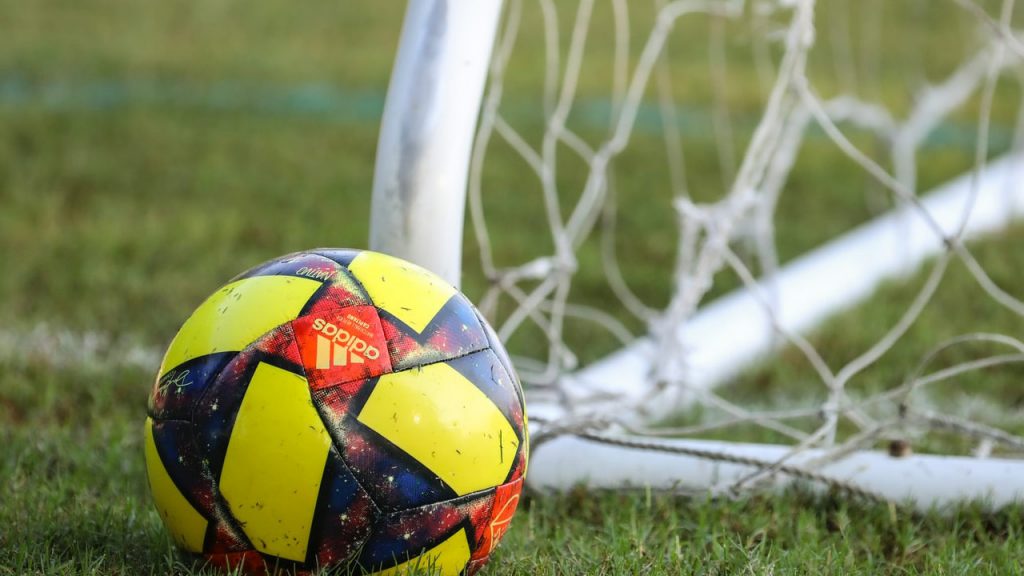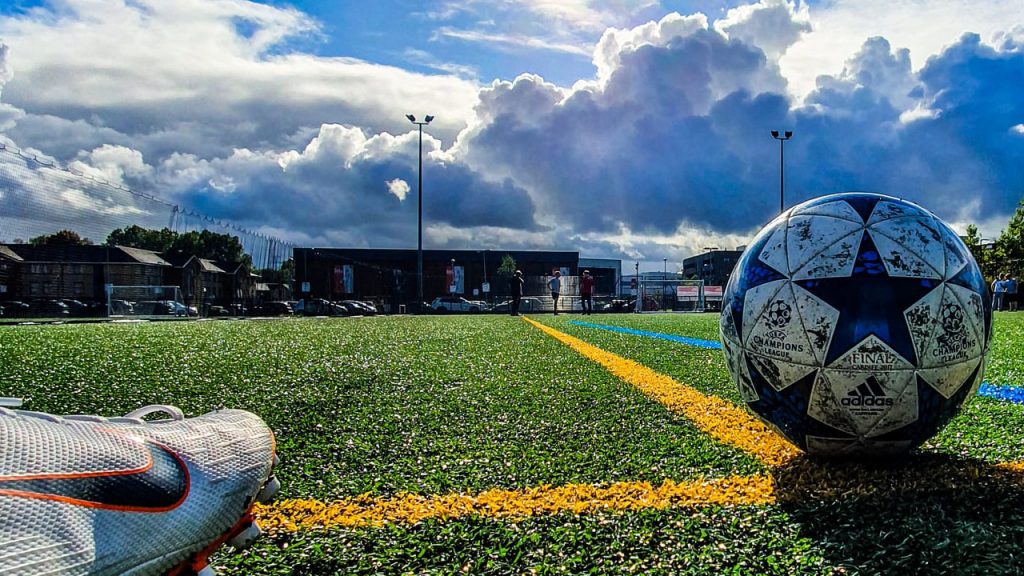Authority Soccer (authoritysoccer.com) is a participant in the Amazon Services LLC Associates Program, an affiliate advertising program designed to provide a means for sites to earn advertising fees by advertising and linking to Amazon.com. This site also participates in other affiliate programs and is compensated for referring traffic and business to them.
Soccer games must follow FIFA laws of the game regarding marking lines for the penalty area, six-yard box, halfway line, and the entire field size.
Playing on an oversized or undersized field will affect the players. The size of Youth soccer fields vary greatly, and we will discuss why in this article. But first, what are the standard official youth soccer field dimensions?
The official rule for the dimensions of standard youth soccer fields is outlined in this table according to the players’ age.
| Age of players | Field Size (in yards) |
| Under 14 | 60 x 100 |
| Under 12 | 50 x 80 |
| Under 10 | 40 x 70 |
| Under 8 | 25 x 50 |
| Under 6 | 15 x 30 |
The official soccer field size for adults ranges from 50-100 X 100-130 yards. However, even for adults, the rules allow soccer field sizes to be reduced for women, players with disabilities, and younger and older players.
What is the standard for the dimensions on the official Youth Soccer Field for marking specific areas on the pitch?
Official Youth Soccer Field Dimensions
The laws stipulated as standard dimensions of all the parts of the soccer pitch are different for youth leagues. This is so that younger soccer players will have the opportunity to better develop their skills.
Hence, they play on smaller pitches according to their age. Otherwise, the young players will spend all of the matches chasing around a huge field and never touching the ball. That would be exhaustive.
To make the game equally interesting for the young players, there are variations in the rules, especially in the lower age groups.
The rules not only affect the size of the pitch but also the number of players to be on the pitch at a time.
What are the dimensions for the soccer pitch according to age?
Official Youth Soccer Field Dimensions By Age Group

In this section, we will discuss the rules as stipulated by FIFA laws.
U6
Children under 6 will play four-a-side soccer. They will often play for 4-10 minutes with four breaks. The size of the soccer field is smaller and should be about 15-20 x 25-35 yards.
The goal post should be smaller too at 4 x 5 feet. They will play without goalkeepers.
U7 – U8
Children at this age will often play five-a-side soccer games without goalkeepers. The soccer field will also be smaller in size.
It should measure 25 yards x 35-40 yards. They will often play for the duration of two 25 minutes halves.
U9 – U10
At this age, players are tall and can run around better. They will often play seven-a-side games.
The FA recommends that the pitches measure 50 yards in width and 70 yards in length. They should play two halves of 30 minutes. The goal should measure 18 x 6 feet.
U11 – U12
As the players advance in age, smaller fields will limit their enjoyment of the game. The soccer field will be bigger. Players that are under 12, and 11 should already be playing nine versus nine on a larger pitch.
They should play for two 30-minute halves.
FIFA recommends that the touchlines should span 70 yards in length by 50 yards in width. The goal will be 18 x 6 feet and each side will play with goalkeepers.
U13 – U14
Players at this age should be playing the standard eleven versus eleven soccer games. The FA recommends that the soccer pitches stretch to 100-130 yards x 50-100 yards.
They would not play the full 90 minutes but the game would be divided into two 35 minute halves. Each goal should measure 24 x 8 feet.
U15 – U16
The pitch again increases in size for players in the 15 – 16 age group.
The soccer field dimensions should be 100-130 yards for the length and 50-100 yards for the width. The goal should measure 8 x 24 feet.
After this age group, youth soccer progresses to full adult leagues. Most of the players in this age range can play standard size soccer fields because of their height and zeal.
Dimensions of the Features on Soccer Fields
The field sizes for U6 to U16 we outlined in this article are based on the recommended guidelines in the US Youth Soccer Modified Rules for youth Play.
For complete information, go to www.usyouthsoccer.org. Each league may vary by age group.
How do you measure the features on the soccer field?
The Pitch
The surface must be a flat level surface with clean-cut grass of no more than 2.5 inches in height. The grass must not have any dangerous defects like exposed sprinkler heads or thorns.
The Goals
The average size for posts and crossbars is 5 inches in width, and the net should be secured to the posts and crossbar.
We have discussed some of the different variations of goal sizes according to the size of the soccer field.
For information on how to properly set up a soccer goal, consider the Guidelines for Movable Soccer Goal Safety.
Marks and Lines
Markings on the soccer field should be made with bold five inches wide lines in white. These markings are used to outline the different parts of the soccer pitch.
The regulation field will be the touchlines measured by the measurements outlined in earlier parts of this article. There will also be another line called restraint lines for spectators.
The restraint line is painted a different color from the touchlines and is a minimum of 5 feet from the edge. Spectators will be on one side, and players should be on the other side of the field.
Then there is the Corner Arc. This arc is measured at a radius of one yard from the respective corner.
Other Features and Equipment
There should be erections of corner flags right on the corner. Posts and mid-field markings should be measured accordingly.
The penalty area is rectangular and extends to each side of the goal and in front of it. Within the penalty area is the penalty spot, which is some yards from the goal line, directly in line with the center of the goal.
A penalty arc adjoins the penalty area, but it is not part of the penalty area and is only relevant when taking a penalty kick.
If you can’t properly size the fields, probably because of irregularities in age and height, it is better to undersize and not oversize the soccer field.
The games will be more fun. The young players will be able to learn more about soccer because of the exciting engagement.

What to Consider When Measuring Soccer Field Dimensions
The official size of soccer fields for adult players ranges from 50 – 100 yards in width and 100 – 130 yards in length.
However, the rules allow for a reduction in the sizes of soccer field sizes for women, players that have special needs, and youths as well as seniors.
One of the worst mistakes a youth soccer league organizer can make is to allow teams to play on oversized fields.
If players have a game on a smaller field, they will have more touches and that will mean more fun. However, some players may not touch the ball at all on an oversized field.
The size of the soccer field for each match must be in accordance with the average age and height of the players.
For instance, if younger players play on a larger field, most of the game time will run out with the players not doing anything but running.
They will get too tired by half-time. The game will then degenerate into long kicks. The players will not be able to learn or implement tactics and team play on an oversized soccer field.
So average athletes who are slower and don’t have much stamina should play on smaller soccer fields.
The size of youth soccer fields should be based on the size of the steps that the average team player can take at a go and the length of their kick.
If the league is “small-sided” or short on players and has to improvise with fewer players on each team, the dimensions of the soccer field maybe even smaller.
As discussed earlier, youth teams should play 4 versus 4, 5 aside, and so on. When playing a “small-sided,” the younger players will have so much fun.
Their game will improve a great deal if you play 3 or 4 per side on a 15 x 25 yards field. They will enjoy non-stop action.
As every one of them gets a lot of touches on the ball, they will make quick, short passes and tactics to make transitions from attack to defense.
FIFA’s “Laws of the Game” are published annually. They are the official rules that guide soccer worldwide. For current rules and field sizes, go to “Laws of the Game” at www.fifa.com or check with.

